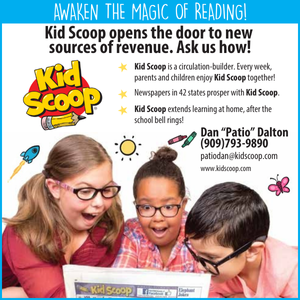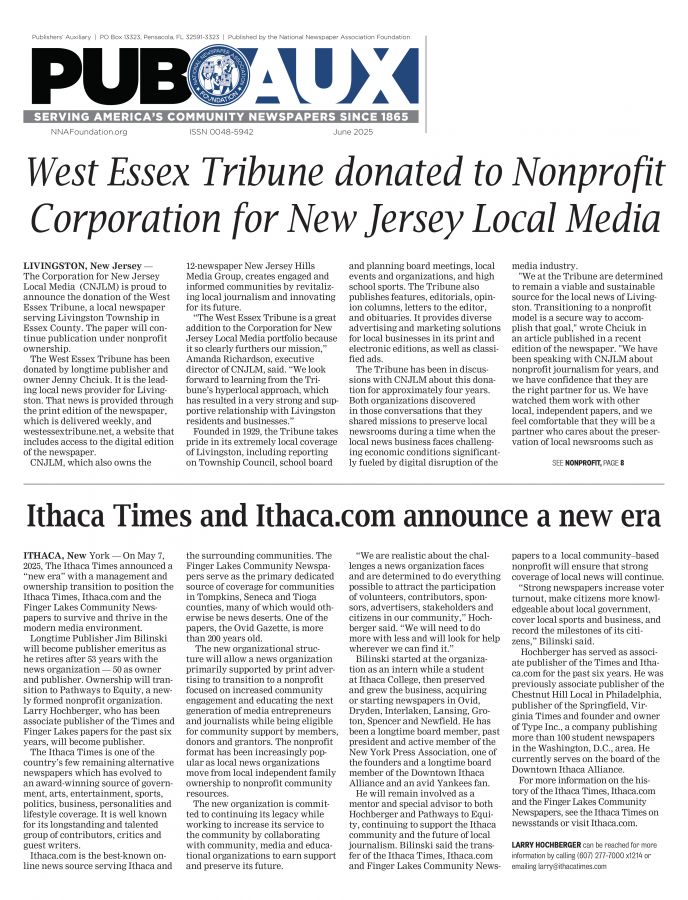Community newspapers should not overlook baby boomers
Sep 11, 2012
By Larry Timbs and Jamie Chrisman Low
Special to Publishers’ Auxiliary
Community newspapers that don’t target news, information and advertising to baby boomers make a huge blunder.
Make that a multi-million dollar debacle.
Consider the numbers
The U.S.’s 77.3 million baby boomers, essentially people born between 1946 and 1964, are the most affluent consumer group in America, spending almost $2 trillion on goods and services each year.
Other notable facts about baby boomers:
• They own a sizable percentage of America’s financial assets.
• They dine out four to five times a week.
• They are good to their progeny, spending $29 billion annually on gifts for their grandchildren.
• They are digitally connected and can’t seem to detach from the Internet; 32 percent of them, for example, use social media (Facebook, Twitter, Blogger, LinkedIn, LiveJournal, Google Maps, Ustream, Pinterest, Flickr, Tumblr, YouTube, etc.) on a daily basis. And almost three out of four baby boomers have a Facebook profile. They don’t get far away from their iPhones or other smartphones; boomers, who know better than anyone that time waits for no one, don’t want to miss out on anything, including social, sexual or professional opportunity. (Remember that, the next time you see a boomer eagerly responding to a ping and chatting on the phone or checking a text at the supermarket.)
A July 2012 Newsweek article described the computer as our “electronic cocaine.” That same article noted that fully one-third of smartphone users (undoubtedly many of them baby boomers) go online before getting out of bed.
On the downside, baby boomers have trouble staying married. The rate at which boomers are becoming single has doubled since 1990.
In addition, whereas it used to be that parents and mental health counselors had their hands full trying to stem the rate of teen suicide, suicide rates for baby boomers seem to be on the upswing. Why? No one knows but there’s speculation that many boomers become deeply depressed and take the ultimate bailout from life when their health goes bad. Depression might also afflict them when their mental faculties decline, or they lose a job, spouse or partner.
News and advertising executives at America’s community newspapers should also know that, for all their wealth, generosity and spending power, many baby boomers can lay claim to being “the most selfish, self-centered folks who have ever walked the face of the earth.” That dire observation is in an Aug. 11, 2011, blog post by Matt McDonald who also notes that baby boomers, by and large, have pretty much been running things (socially, politically and economically) in the U.S. for the last several decades.
“Look no farther than the current financial, debt and social crisis we are facing,” McDonald wrote. “Who has been in charge for the last 30 years? Right, boomers. They were in charge of Wall Street, the banks and Washington. And none gave a damn about anyone except themselves.”
However, anyway you look at what boomers have done or not done, they’ve had it tough.
Consider a sampling of what they’ve been hit with: Vietnam; Kent State; the murders of JFK, MLK and Robert Kennedy; a U.S. president who resigned in disgrace; OJ, the white Bronco chase and the trial of the century; the explosion of the Challenger space shuttle; interminable, escalating tension in the Middle East; terrorism (on scales never before seen by Americans) in Oklahoma City and at the World Trade Center in New York; the unpredictable, bothersome missile launches from North Korea; ravaging wars in Iraq and Afghanistan; a nuclear Pakistan that’s hard to discern as friend or foe; a near collapse of the U.S. economy that still has our housing market in dire straits; escalating prices for food, fuel and electrical power.
No wonder so many baby boomers are depressed, hurting or want to give up the ghost.
How community newspapers can be more baby boomer savvy
So how to appeal—journalistically and marketing wise—to this growing complex demographic that has already radically transformed American life and will continue to do so at an ever increasing pace? (For the next 18 years, boomers will be turning 65 at the rate of 8,000 a day.)
How to win over the baby boomers’ eyeballs and circulation and advertising dollars?
Start by writing about stuff that boomers care deeply about. Cover the things that they have a personal stake in.
Because the mental health needs of older adults are growing at an exponential rate, and because boomers increasingly are dealing with grief and loss, write about support groups, informational workshops and treatment centers in the local community.
And because boomers are beset with such quality of life issues as declining physical health, obesity, divorce, sexual dysfunction, reduction of income or an adult child moving back home, cover these topics frequently and pervasively in your community newspaper.
That’s right. We need less attention in community newspapers to who seconded what motion at a school board meeting and more coverage about local crisis assistance agencies. Less of a spotlight on bland, traditional “society news” and more coverage about good nutrition for seniors or how they can stay fit.
And because boomers are so enamored of the Internet, social media and their smartphones, community newspapers need to set aside space for coverage of the latest and most popular features of Facebook, Twitter, YouTube, etc.
If community newspapers aren’t covering popular components of that “electronic cocaine’’—that is to say, if they are not writing cutting edge stuff about digital/online culture—they may well be doomed.
Taking into account what baby boomers love, and how technology is defining their lives, or “rewiring us,” as that Newsweek article notes, how, pray tell, can community newspapers not pay greater homage to coverage of online technology?
And how can community newspapers expect to win the hearts, minds (and wallets) of baby boomers if they are not multimedia?
It’s not that the printed paper is dead or that it’s even dying. A widely distributed recent e-mail message from Michelle Rea, executive director of the New York Press Association/New York Press Service, spoke of the strong, powerful, educated audience of consumers that read newspapers on a regular basis.
Two telling statistics from Rea’s upbeat e-mail: 80 percent of households earning $100,000 or more read newspapers. And 85 percent of adults with advanced degrees read newspapers. What was not mentioned in that same e-mail is that many of those folks are baby boomers.
On that same note, it has long been believed that the printed paper would be around as long as baby boomers are with us, according to a November 2011 Huffington Post article written by Paul Briand.
That may be true, but boomers today want and expect far more than just printed text when they access a newspaper’s website. Better dazzle them with text and lots of still photos and audio and video—on stuff near and dear to their hearts.
Boomers have their iPads and iPhones, so their newspaper reading preferences have definitely changed. They want more from their newspapers than ever, and they want it faster and in multimedia form.
From an advertising perspective, community newspapers might be well served to publish special baby boomer sections or a regular page (even a regular double truck spread) devoted to goods and services sought by baby boomers. It’s easy to envision boomer oriented news and feature stories in such a section with ads about travel and leisure opportunities, health and fitness, medical and pharmaceutical services, and eating establishments that offer good discounts for seniors. For good measure, throw in a few QR codes in those ads because boomers love to scan them with their smartphones.
Bottom line: Make your community newspaper vibrant, relevant and healthy by giving baby boomers a good chunk of multimedia content in each issue.
As a community newspaper executive, you know, deep down, what baby boomers are interested in. That’s because you yourself are likely a baby boomer. Take a step back and ask yourself these questions: “If I’m a typical boomer with my smartphone or iPad, am I really going to spend much time wading through a 25-inch city council story on sewer rates? And is that picture of all those white guys in ties sitting around a conference table going to quicken any boomer’s heart?”
We rest our case.
Larry Timbs, a baby boomer, is a retired associate professor of mass communication at Winthrop University. His recently acquired iPhone is changing his life. Jamie Chrisman Low, who barely missed the boom, is an administrative specialist in the Department of Mass Communication at Winthrop. Most of her waking hours are spent on either a PC or Mac, and she sends/receives about 2,000 text messages a month. Some of the material for this article came from a graduate course presentation Low made in July 2012 at Winthrop. She is pursuing a master’s degree in counseling and development. larrytimbs@gmail.com







